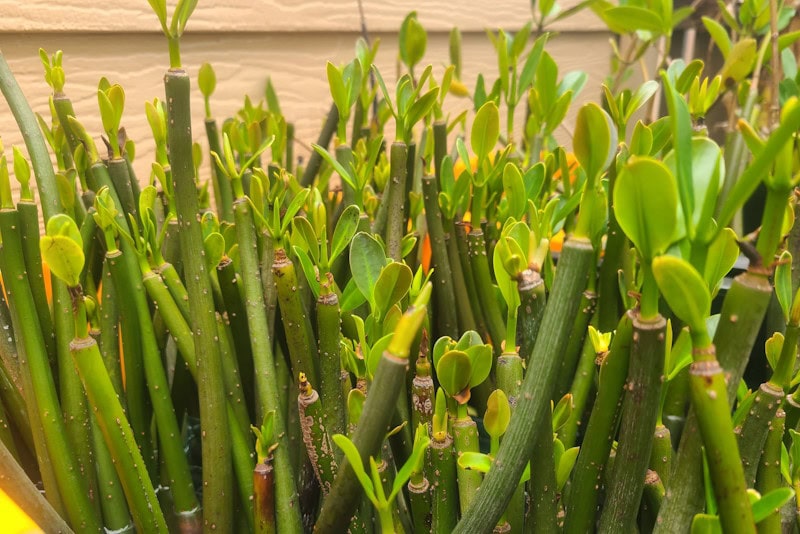
Adding mangroves to your aquarium can be a rewarding and visually stunning way to enhance your aquatic environment. These resilient plants not only look great, but they also provide natural filtration, helping to maintain water quality in your tank. However, keeping mangroves in an aquarium requires some specific care to ensure they thrive.
As someone who has spent years cultivating these unique plants, both for my aquariums and for Save Mangroves Nursery, I’m excited to share some insights and tips to help you successfully keep mangroves in your own tank.
Why Add Mangroves to Your Aquarium?
The Benefits of Mangroves
Mangroves are unique plants that can thrive in saltwater, freshwater, or brackish environments, making them incredibly versatile for aquarium settings. They have a remarkable ability to filter out toxins from the water, stabilize substrate, and create a natural habitat for various species of fish and invertebrates.
✅ Good: Natural Filtration
Mangroves help remove nitrates, phosphates, and other harmful substances from the water, improving overall water quality and reducing the need for chemical filtration.
✅ Good: Habitat Creation
The intricate root systems of mangroves provide shelter and breeding grounds for fish and invertebrates, adding to the biodiversity of your tank.
❌ Bad: Space Requirements
Mangroves can grow quite large over time, and their roots need space to spread. In a small tank, this could become an issue if not managed properly.
Setting Up Your Aquarium for Mangroves
Choosing the Right Tank Size
When it comes to keeping mangroves in your aquarium, size matters. Mangroves can grow into substantial plants, so it’s essential to provide enough space for their roots and leaves to develop.
🛑 Mangrove Fact: Mangroves can grow up to 80 feet tall in the wild, but in an aquarium, their growth is typically limited to a few feet due to pruning and environmental conditions. If you’re loving mangrove plants so far, you’ll love this article on 5 Ways To Protect Mangroves.
Pros of a Larger Tank
- More space for root expansion
- Better stability for water parameters
- Greater flexibility in aquascaping
Cons of a Smaller Tank
- Limited root growth
- Increased maintenance requirements
- Potential for overcrowding
From my experience, starting with a tank of at least 40 gallons is ideal for keeping one or two mangroves. This size allows ample space for root growth and helps maintain stable water conditions.
Substrate and Root Support
Mangroves need a stable substrate that can support their roots without compacting too much. Sand or fine gravel works well, allowing the roots to penetrate and anchor the plant securely.
✅ Good: Sand or Fine Gravel Substrate
Provides stability for roots while allowing water flow, which helps prevent anaerobic pockets.
❌ Bad: Dense or Compacted Substrate
Can suffocate the roots and limit their ability to absorb nutrients and oxygen.
One personal anecdote that comes to mind is when I first tried growing mangroves in a tank with large gravel. The roots struggled to penetrate the substrate, leading to stunted growth. Switching to a finer sand substrate made all the difference, and the mangroves began to thrive.
Lighting and Water Quality
Providing Adequate Lighting
Mangroves require proper lighting to photosynthesize and grow. In their natural habitat, they receive plenty of sunlight, so it’s essential to replicate this in your aquarium. Full-spectrum LED lights that mimic sunlight work best.
🛑 Fun Fact: Mangroves have a unique ability to store salt in their leaves and later excrete it, allowing them to survive in salty environments where other plants cannot. Find out why you need mangrove plants in your aquarium.
✅ Good: Full-Spectrum LED Lighting
Mimics natural sunlight, promoting healthy growth and vibrant leaf coloration.
❌ Bad: Inadequate or Incorrect Lighting
Can lead to yellowing leaves, slow growth, or even plant death.
Maintaining Water Quality
Mangroves are hardy plants, but they still require good water quality to thrive. Regular water changes, monitoring salinity levels, and maintaining a balanced nutrient profile are crucial.
✅ Good: Regular Water Changes
Helps remove excess nutrients and waste, keeping water conditions optimal for mangrove growth.
❌ Bad: Neglecting Water Quality
Can lead to poor plant health, algae blooms, and water parameter fluctuations.
Caring for Your Mangroves
Pruning and Root Management
Mangroves can grow quite large, so regular pruning is necessary to keep them manageable in an aquarium setting. Pruning the leaves and roots will help control the size of the plant and encourage new growth.
✅ Good: Regular Pruning
Encourages healthy growth and prevents the plant from outgrowing the tank.
❌ Bad: Overcrowding
Allowing the mangroves to grow unchecked can lead to overcrowding and competition for resources in the tank.
From my own experience, I learned that pruning is not just about keeping the plant small but also about promoting a healthy structure. When I first started with mangroves, I was hesitant to prune them, thinking it might harm the plant. However, once I began pruning regularly, I noticed a significant improvement in their growth and overall health.
Fertilization and Nutrient Requirements
Mangroves are not heavy feeders, but they do benefit from occasional fertilization, especially in a controlled aquarium environment where nutrients may be limited.
✅ Good: Occasional Fertilization
Using a balanced aquarium plant fertilizer can support healthy growth, especially in tanks with limited nutrients.
❌ Bad: Over-Fertilization
Too much fertilizer can lead to nutrient imbalances, algae blooms, and poor water quality.
🛑 Mangrove Fact: Mangroves are one of the few plant species that can grow in waterlogged soils with little oxygen, thanks to their unique root structures that allow them to breathe.
Common Challenges and How to Overcome Them
Dealing with Yellowing Leaves
Yellowing leaves are a common issue with mangroves, often caused by nutrient deficiencies, poor lighting, or improper water conditions.
✅ Good: Monitor and Adjust Conditions
Regularly check water parameters, lighting, and nutrient levels to ensure they meet the needs of your mangroves.
❌ Bad: Ignoring Signs of Stress
Failing to address yellowing leaves can lead to further decline and potentially kill the plant.
Managing Salinity Levels
Mangroves are adaptable, but sudden changes in salinity can stress the plants and affect their growth. It’s important to maintain stable salinity levels, especially if you’re keeping mangroves in a brackish or saltwater tank.
✅ Good: Gradual Adjustments
If you need to change the salinity, do so gradually to avoid shocking the mangroves.
❌ Bad: Rapid Salinity Changes
Sudden shifts in salinity can cause stress and even damage to the mangroves.
Mangroves are a unique and rewarding addition to any aquarium, offering natural filtration, habitat creation, and a touch of coastal beauty. By providing the right environment, lighting, and care, you can ensure your mangroves thrive and continue to benefit your aquatic ecosystem.
Whether you’re a seasoned aquarium enthusiast or just starting out, understanding the care requirements of mangroves will help you keep these fascinating plants thriving in your tank for years to come.
How Do I Choose My Very First Plant?
So you have learned about the incredible benefits of adding mangrove plants to your tank, but you still don’t know which exact plant to add to your specific tank size?
Don’t worry, because we’ve created an easy Step-by-Step guide to help you with your selection process.
Click the button below to find out which plant is perfect for your aquarium.

 Cart is empty
Cart is empty 
